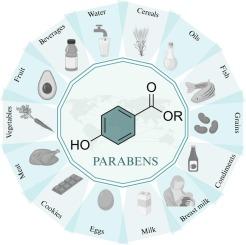世界范围内对羟基苯甲酸酯摄入的系统分析。来源和食品类别的范围审查
IF 9.8
1区 农林科学
Q1 CHEMISTRY, APPLIED
引用次数: 0
摘要
对羟基苯甲酸酯是一种防腐剂,广泛用于化妆品、药品和食品中,由于其潜在的内分泌干扰化学物质(EDCs)而引起人们的关注。根据PRISMA的指导方针,这项研究分析了全球食品中对羟基苯甲酸酯的浓度,没有时间或地理限制。在最初确定的713种物品中,有75种被归入14种食品类别。在欧洲联盟(EU),对羟基苯甲酸甲酯含量最高,在乳制品(302.82 ng g−1)、蔬菜(231.90 ng g−1)和鸡蛋(229.90 ng g−1)中检测到,尽管在监管安全限制范围内。然而,从多种受污染的食物来源中累积暴露可能导致超过ADI。在欧盟以外,特别是在中国和沙特阿拉伯,据报告加工调味品(对羟基苯甲酸甲酯:495700.00 ng g−1)、蔬菜(对羟基苯甲酸乙酯:312600.00 ng g−1)和饼干(对羟基苯甲酸甲酯:253700.00 ng g−1)中的浓度较高,其含量远远超过欧盟的水平。需要在全球范围内加强控制,以减少通过食物接触对羟基苯甲酸酯。本文章由计算机程序翻译,如有差异,请以英文原文为准。

Worldwide systematic analysis of dietary paraben exposure. A scoping review of sources and food categories
Parabens are preservatives that are widely used in cosmetics, pharmaceuticals, and foods, which raise concern due to their potential as endocrine-disrupting chemicals (EDCs). According to PRISMA guidelines, this study analyzes paraben concentrations in foods globally, with no temporal or geographical restrictions. Of the 713 initially identified articles, 75 were included and classified into 14 food groups. In the European Union (EU), the highest levels pertained to methylparaben and were detected in dairy products (302.82 ng g−1), vegetables (231.90 ng g−1) and eggs (229.90 ng g−1), albeit within regulatory safety limits. However, cumulative exposure from multiple contaminated food sources could lead to the ADI being exceeded. Outside of the EU, especially in China and Saudi Arabia, higher concentrations were reported in processed condiments (methylparaben: 495700.00 ng g−1), vegetables (ethylparaben: 312600.00 ng g−1) and cookies (methylparaben: 253700.00 ng g−1), with levels far exceeding those found in the EU. Stronger worldwide controls are required to reduce paraben exposure through food.
求助全文
通过发布文献求助,成功后即可免费获取论文全文。
去求助
来源期刊

Food Chemistry
工程技术-食品科技
CiteScore
16.30
自引率
10.20%
发文量
3130
审稿时长
122 days
期刊介绍:
Food Chemistry publishes original research papers dealing with the advancement of the chemistry and biochemistry of foods or the analytical methods/ approach used. All papers should focus on the novelty of the research carried out.
 求助内容:
求助内容: 应助结果提醒方式:
应助结果提醒方式:


